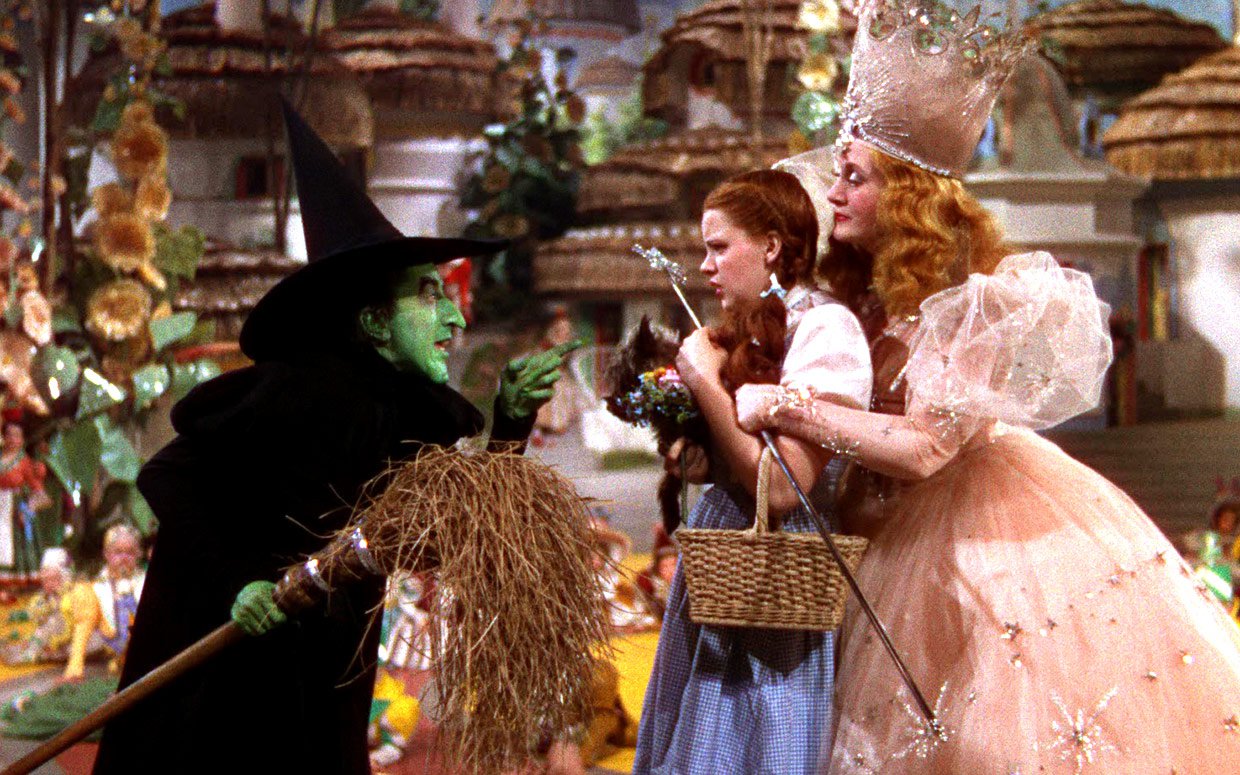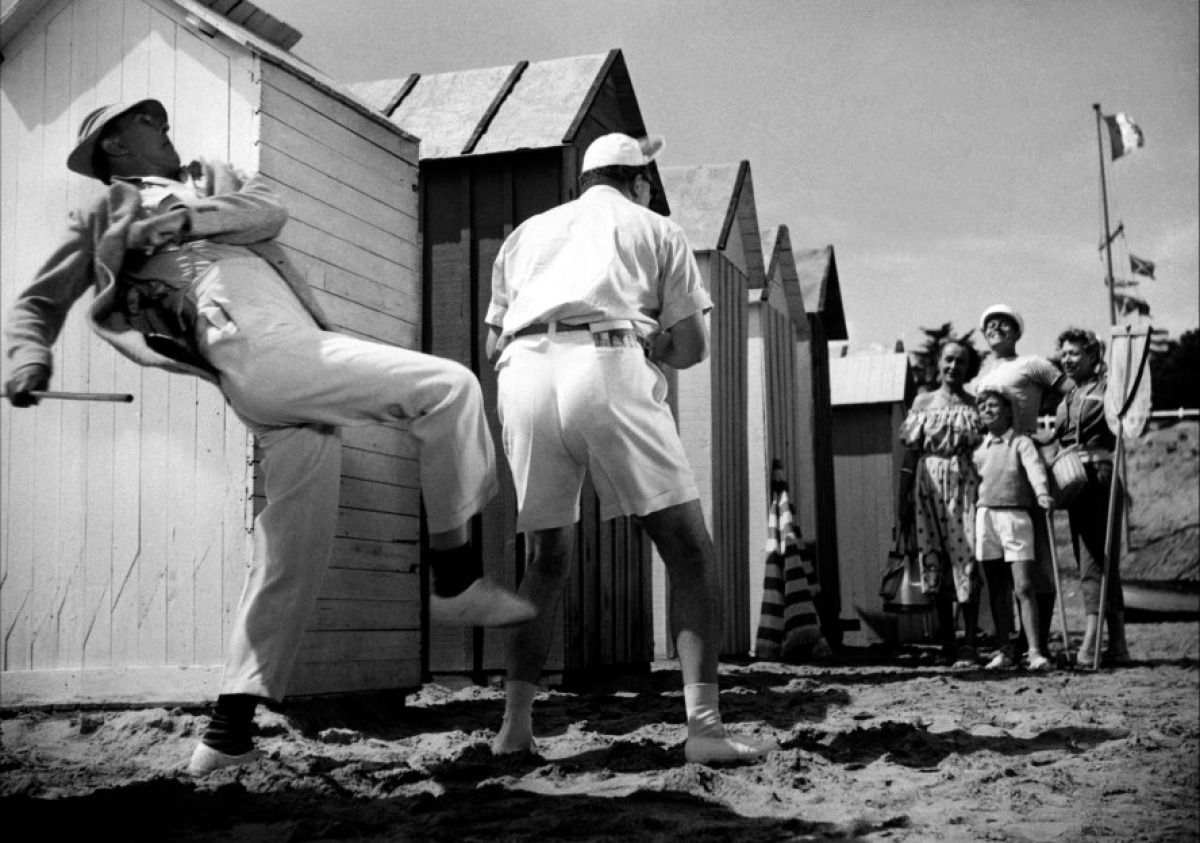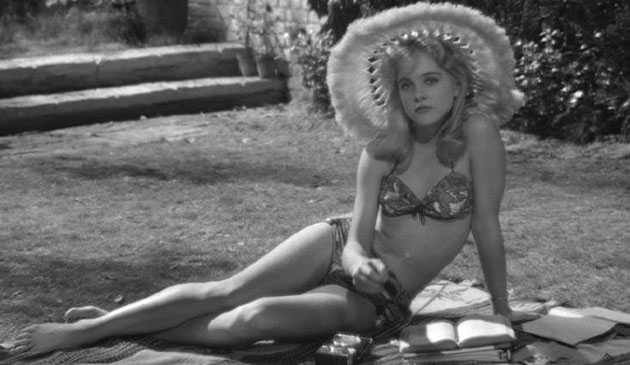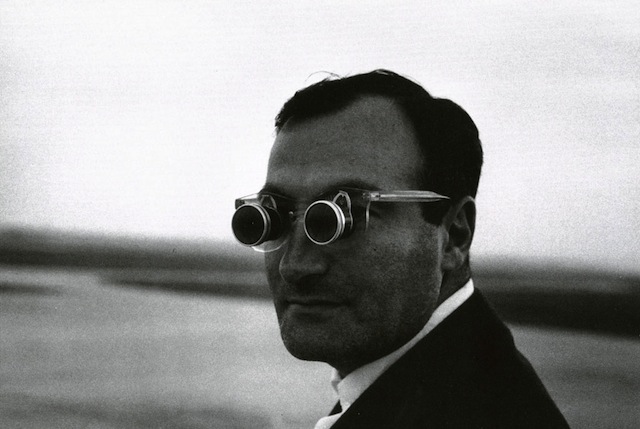6. Monsieur Hulot’s Holiday (Jacques Tati, 1953)
Perhaps not the most obvious film that influenced Lynch, Jacques Tati’s film has nevertheless been cited several times by the American director as one of his all-time favorites. Tati has often been seen as the French Charlie Chaplin or Buster Keaton—Hulot, a recurring character played by Tati himself, is a bumbling and mostly mute hero very much in the Chaplin mold.
But Tati also had a phenomenal mind for creating complex multiple-character set-pieces that reward repeated viewing. His later film, Playtime, is perhaps his masterpiece, if only for the mind-boggling set-design. Tati, like Chaplin and Keaton, has earned the has continued to impress both high-brow critics and popular audiences for decades—while the comedy is popular, slapstick stuff (albeit with impeccable comic timing), the artistry involved in all his films is undeniable.
Thinking a little more deeply about Lynch films in relation to Tati, we can see where the influence comes in. We all too often focus on the darker aspects of Lynch’s aesthetic, but there is a lot of comedy in his work to; yes, it’s often very dark comedy, but there is also a strain of clownish slapstick—think of Andy in Twin Peaks, for example, or the scene in Mulholland Dr. where the blonde hitman makes a total mess of his hit. It’s one of the under-acknowledged talents of Lynch—pure physical comedy that’s worthy of the old masters of the form.
7. Vertigo (Alfred Hitchcock, 1958)
Lacking the sensationalism of Psycho or The Birds, Vertigo opened to a mixed reception, but it’s now firmly established as Hitchcock’s masterpiece, often topping lists of the best films ever made. Lynch is obviously influenced by many Hitchcock films, but Vertigo is certainly the most Lynchian of Hitchcock’s films.
Vertigo is an obvious precursor to Bergman’s Persona and Lynch’s Mulholland Dr., Lost Highway and Inland Empire in how it deals with the question of identity. But it’s also an obvious influence on the other films by Lynch with involve detection (Blue Velvet and Twin Peaks: Fire Walk With Me for example).
Lynch has often expressed his fondness for James Stewart. Stewart’s general innocence and kind-heartedness seems to resurface in many of Lynch’s protagonists, particularly those played by Kyle MacLachlan.
8. Lolita (Stanley Kubrick, 1962)
Lolita is one of Stanley Kubrick’s most undervalued films, perhaps because it’s his most subtle. It’s not difficult to see how it might have influenced Twin Peaks, given its notoriously dark subject matter. Laura Palmer may be older than Lolita, but both have a surface innocence that is gradually revealed to be an artifice projected and supported by those around them.
Based on Vladimir Nabokov’s novel of the same name, the film’s protagonist is Humbert Humbert, a highly cultured pedophile who develops an overwhelming attraction to the daughter of a widow he lodges with in New Hampshire. Kubrick wasn’t able to be as explicit as Nabokov in his treatment of the plot, unsurprising given the book had been banned in several countries. Kubrick had started working on the film before realizing how restricted he would be in what he could depict.
Nowadays, most viewers, especially after seeing the rather crass 1997 adaptation, would agree that these restrictions are what make the film so masterful. Kubrick had to leave a lot to the audience’s imagination—and there’s an art to doing that without being merely opaque. Kubrick meets the challenge by making the most of an excellent cast, a smart script, and a superior eye for detail.
The film does lack some of the uncanny creepiness of the novel. The novel is almost entirely told from the perspective of Humbert, which makes for a uniquely unsettling perspective. The film does have a voice-over, with a lot of lines taken directly from the novel, but it’s used somewhat sparingly.
One big and successful change that Kubrick makes for the film is to radically expand the role of Quilty, Humbert’s private detective nemesis. Quilty is played by Peter Sellers, and Kubrick gave the comic actor the perfect opportunity to demonstrate his talents. It’s not difficult to see how this character has influenced the quirky detectives who appear in many of Lynch’s films.
9. La jetée (Chris Marker, 1962)
For a French short film that consists mostly of still, black and white images, Chris Marker’s La Jetée (“The Jetty”) has proven remarkably influential. Fans of Terry Gilliam’s Twelve Monkeys will find the plot familiar, since Gilliam’s film is directly based on elements of La Jetée. The film uses a highly unusual format—one might even (unfairly) say that it’s un-cinematic, for the only movement on screen (except for one key scene) comes from transitions between still images.
It’s inspired by a genre of novel called the the photo-roman, which was popular in France and Italy in the sixties and seventies. These novels were similar to graphic novels, except they used photos instead of cartoons. Marker’s film is therefore somewhat postmodern in how it adapts a popular form and turns it into something strange and new, something that Lynch is also a master of. Marker even uses stock sounds from the same collection that Ed Wood used for his infamous Plan 9 From Outer Space.
La Jetée is a science fiction film, albeit an unconventional one. The protagonist is a World War III survivor who is subjected to risky time travel experiments. It’s comparable to Alain Resnais’ Je T’Aime Je T’Aime as a philosophically complex French New Wave film about time travel. Both films are more about memory and human experience than the science of time travel.
10. The Wizard of Oz (King Vidor et. al, 1939)

The Wizard of Oz is probably only an obvious influence on Lynch if you’ve watched his Wild at Heart. Mike Hartmann has described Wild At Heart as Lynch’s homage to The Wizard of Oz. Many of the characters are clearly analogous to Wizard of Oz characters – Lula even clicks a pair of red slippers at one point to get herself out of some trouble.
Lula’s mother (played by Laura Dern’s real-life mother) is the Wicked Witch. And, apologies if this is a spoiler, Twin Peaks’ Sheryl Lee descends from the sky to deliver a message of love to Nicolas Cage’s Sailor. Where the Wizard of Oz had its characters sing “Somewhere Over the Rainbow” at this point, Sailor sings Elvis Presley’s “Love me Tender”.
While Wild At Heart is Lynch’s most obvious tribute to The Wizard of Oz, it has in fact been argued that many more of his films display the film’s influence. Lynch’s most successful films all involve a descent from innocence into a darker, stranger world—be it a world of dark sexual drives (Blue Velvet) or a world of empty but dazzling promises (Mullholland Dr.).
These passages into different worlds are figured in various ways. In Mullholland Dr. there’s the blue box, in Blue Velvet there’s the severed ear. In Twin Peaks, there’s a famous scene where the camera spins (tornado-like) through a hole in the wall to a close-up of Leland Palmer. Lynch’s protagonists are often swept away like Dorothy from Kansas.



